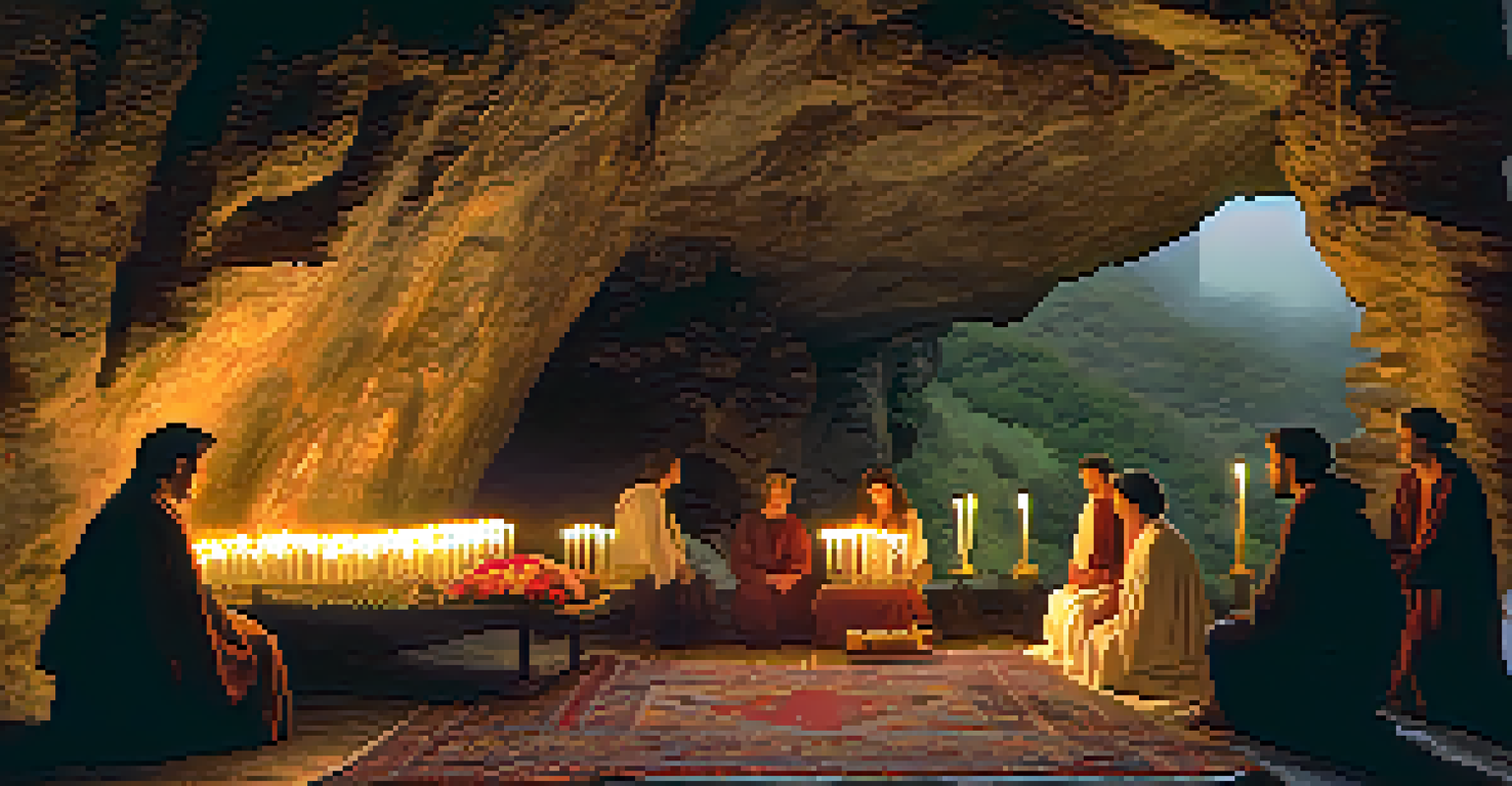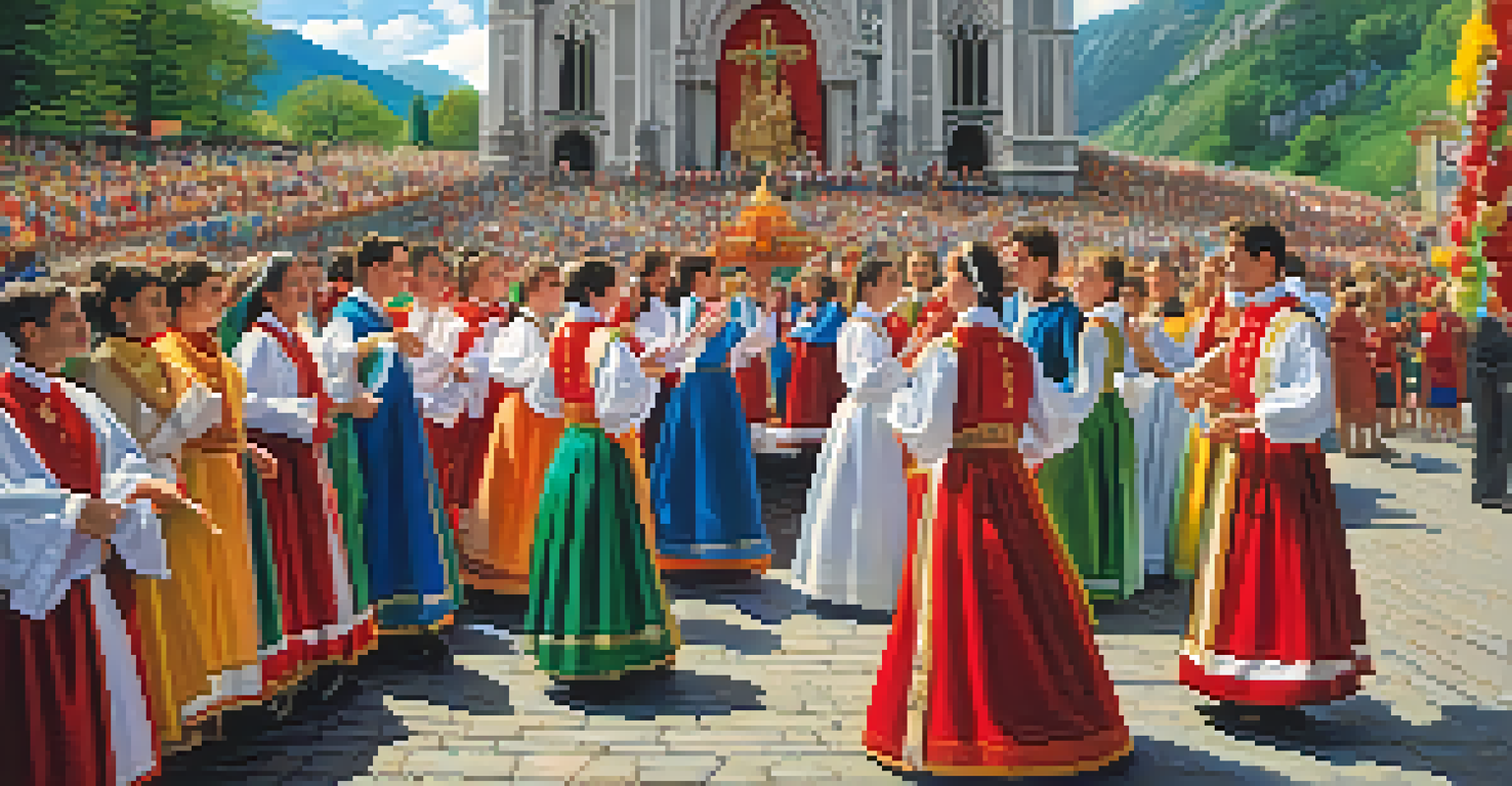The Role of the Shrine of Covadonga in Spanish Catholicism

Historical Background of the Shrine of Covadonga
The Shrine of Covadonga, located in the Asturias region of Spain, dates back to the 8th century. It was built to honor the Virgin Mary, who is believed to have played a pivotal role in the Christian reconquest of the Iberian Peninsula. This site is not just a religious landmark; it symbolizes the cultural and historical identity of the Asturian people.
The beauty of the Shrine of Covadonga is not just in its architecture, but in the faith it inspires among those who visit.
Legend has it that the Battle of Covadonga in 722 AD marked the beginning of the Reconquista, a series of campaigns to reclaim territory from the Moors. This battle, fought in the nearby mountains, is a cornerstone of Spanish history and forms the backdrop for the shrine's establishment. The site has thus become a place of pilgrimage and reverence for many Spaniards.
Over the centuries, the shrine has evolved, with various structures added to enhance its spiritual significance. Today, it attracts thousands of visitors and pilgrims each year, all drawn by its rich history and the promise of divine grace. The blending of history and faith at Covadonga creates a unique atmosphere that resonates deeply with those who visit.
Architectural Significance of the Shrine
The architecture of the Shrine of Covadonga is a stunning combination of Gothic and Romanesque styles, reflecting the artistic trends of various periods. The most notable structure is the Basilica of Santa María la Real de Covadonga, which was completed in the early 20th century. Its majestic spires and intricate stonework draw the eye and inspire awe among visitors.

Surrounding the basilica are natural landscapes, including lush forests and dramatic cliffs, which add to the shrine's ethereal beauty. This harmonious connection between human creation and nature enhances the spiritual experience for pilgrims, creating a serene environment for reflection and prayer. Many visitors describe feeling a sense of peace as they immerse themselves in the tranquility of the site.
Historical Significance of Covadonga
The Shrine of Covadonga symbolizes the cultural identity of Asturias and marks the beginning of the Reconquista in Spanish history.
Additionally, the shrine houses a cave that is said to be the resting place of the Virgin of Covadonga. This cave is not only a place of worship but also a symbol of protection and hope for the faithful. The interplay of architecture and natural elements at Covadonga serves as a powerful reminder of the divine presence in everyday life.
The Virgin of Covadonga: A Central Figure
The Virgin of Covadonga holds a central place in the hearts of Spanish Catholics, particularly in Asturias. She is often depicted as a compassionate mother figure, providing solace and protection to those in need. Her image can be found throughout the shrine, inspiring devotion and reverence among visitors.
Pilgrimage is a journey of the heart, where faith meets the road and every step is a prayer.
Many pilgrims come to Covadonga to seek her intercession for various life challenges, from health issues to personal struggles. This connection to the Virgin is not just spiritual; it fosters a sense of community among those who share similar hopes and prayers. The shared devotion creates an atmosphere of unity and collective faith.
Celebrations and feasts dedicated to the Virgin attract thousands each year, with the most notable taking place on September 8th. During this time, the shrine comes alive with music, prayer, and cultural traditions that honor both the Virgin and the regional heritage. Such events reinforce the role of the Virgin of Covadonga as a beloved figure in Spanish Catholicism.
Pilgrimage Traditions at Covadonga
Pilgrimage to the Shrine of Covadonga has been a tradition for centuries, drawing people from various regions of Spain. Many pilgrims undertake long journeys, often on foot, to express their devotion and seek blessings. This act of pilgrimage is not just a physical journey but a spiritual one, symbolizing the desire for closeness to God.
The journey to Covadonga is filled with personal stories of faith and resilience. For some, it is a way to honor family traditions or commemorate significant life events. The shared experiences of pilgrims, often recounted during their travels, strengthen the bonds within the community and highlight the importance of faith in their lives.
Architectural Beauty and Harmony
The shrine showcases a stunning blend of Gothic and Romanesque architecture, harmoniously integrated with the surrounding natural landscapes.
Upon arrival, pilgrims often participate in religious ceremonies, including Mass and confessions. These rituals provide an opportunity for spiritual renewal and reflection, allowing visitors to deepen their connection to their faith. The pilgrimage experience at Covadonga serves as a reminder of the enduring power of belief and the importance of community in spiritual journeys.
Cultural Impact of the Shrine on Spanish Society
The Shrine of Covadonga is not just a religious site; it plays a vital role in the cultural fabric of Spain. It serves as a symbol of regional pride for Asturians and is often associated with themes of resilience and identity. The shrine embodies the spirit of the Reconquista, making it a powerful emblem in Spanish history.
Art, literature, and music have all been influenced by the shrine, with many artists drawing inspiration from its rich history and spiritual significance. Local folklore often features tales of the Virgin of Covadonga, showcasing her as a protector and guide for the people. This cultural reverence for the shrine continues to be passed down through generations.
The shrine also promotes tourism, contributing to the local economy while fostering appreciation for the region's history and traditions. Visitors leave Covadonga with a greater understanding of its cultural importance, further intertwining faith with national identity. The shrine remains a living testament to the enduring influence of Catholicism in Spanish society.
Festivals and Celebrations at Covadonga
Festivals at the Shrine of Covadonga are vibrant displays of faith, culture, and community spirit. The most prominent celebration is the Feast of Our Lady of Covadonga, observed on September 8th, which attracts thousands of devotees. During this time, the shrine is adorned with flowers, and the air is filled with hymns and prayers that resonate throughout the mountains.
Participants often wear traditional Asturian attire, showcasing the region's rich cultural heritage. The festive atmosphere includes music, dance, and local gastronomy, allowing attendees to celebrate not only their faith but also their regional identity. This blend of religious and cultural festivities creates a unique experience that strengthens communal ties.
Cultural Celebrations and Community
Festivals at Covadonga unite the community through vibrant displays of faith and regional traditions, reinforcing the importance of shared beliefs.
These celebrations serve as a reminder of the importance of faith in daily life and the joy that comes from shared traditions. They offer an opportunity for reflection, gratitude, and renewal of spiritual commitments. As the community gathers to honor the Virgin, they reaffirm their connection to both their faith and each other.
The Shrine's Role in Modern Spanish Catholicism
In contemporary Spain, the Shrine of Covadonga continues to play a significant role in the landscape of Catholicism. It serves as a spiritual refuge for many in a rapidly changing society where faith can sometimes feel overlooked. The shrine stands as a beacon of hope and tradition, inviting people to reconnect with their spiritual roots.
Amidst the challenges faced by the Catholic Church today, such as declining attendance and shifting beliefs, Covadonga remains a vital center for pilgrimage and worship. It offers programs and events that engage both the faithful and those seeking spiritual exploration. This adaptability ensures that the shrine remains relevant in modern times.

Additionally, the shrine fosters interfaith dialogue and community outreach, emphasizing the importance of compassion and understanding in religious practice. By bridging the gap between tradition and modernity, the Shrine of Covadonga continues to inspire devotion and serves as a testament to the enduring nature of faith in Spanish culture.